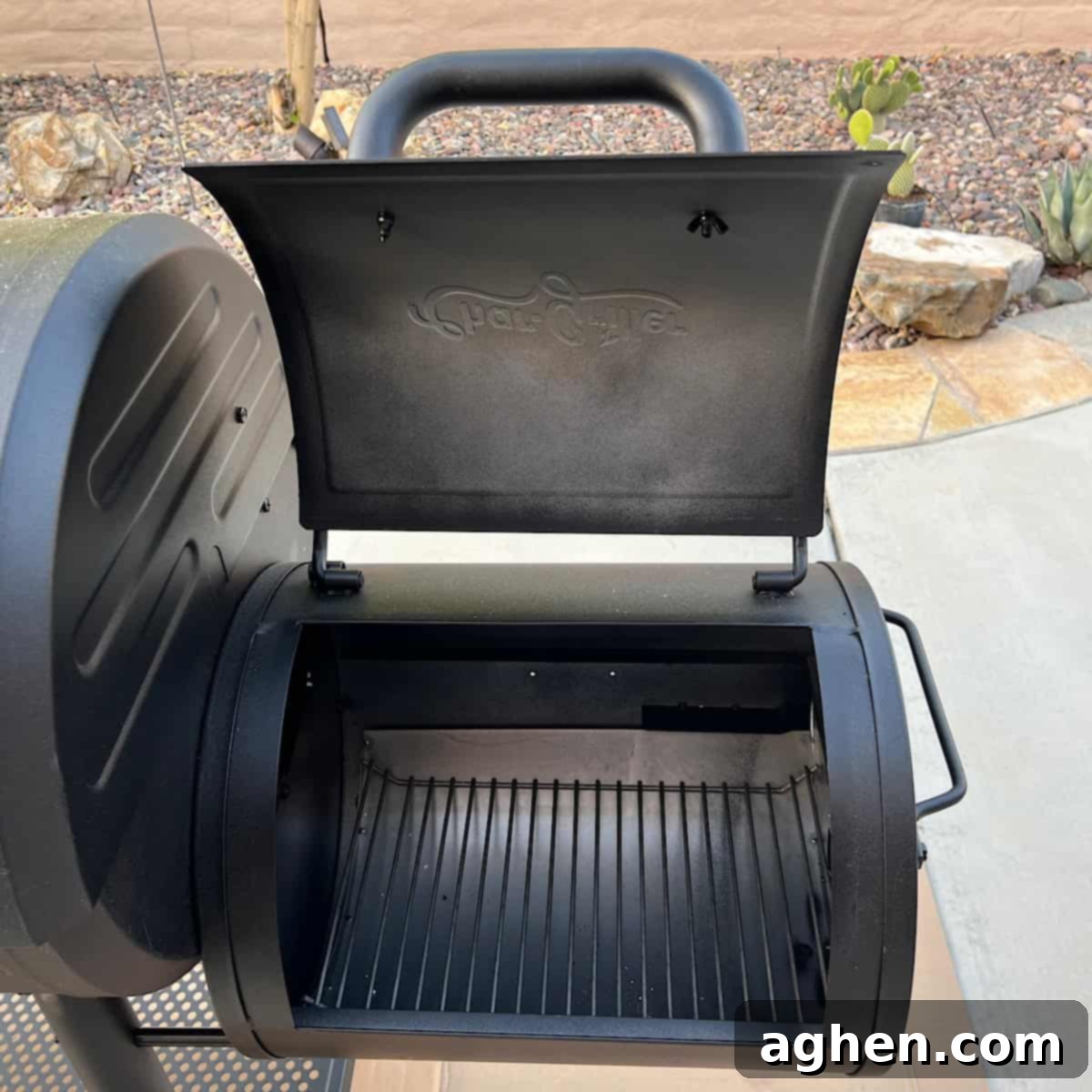Mastering the Art of Offset Smoking: Your Ultimate Beginner’s Guide to Authentic Barbecue
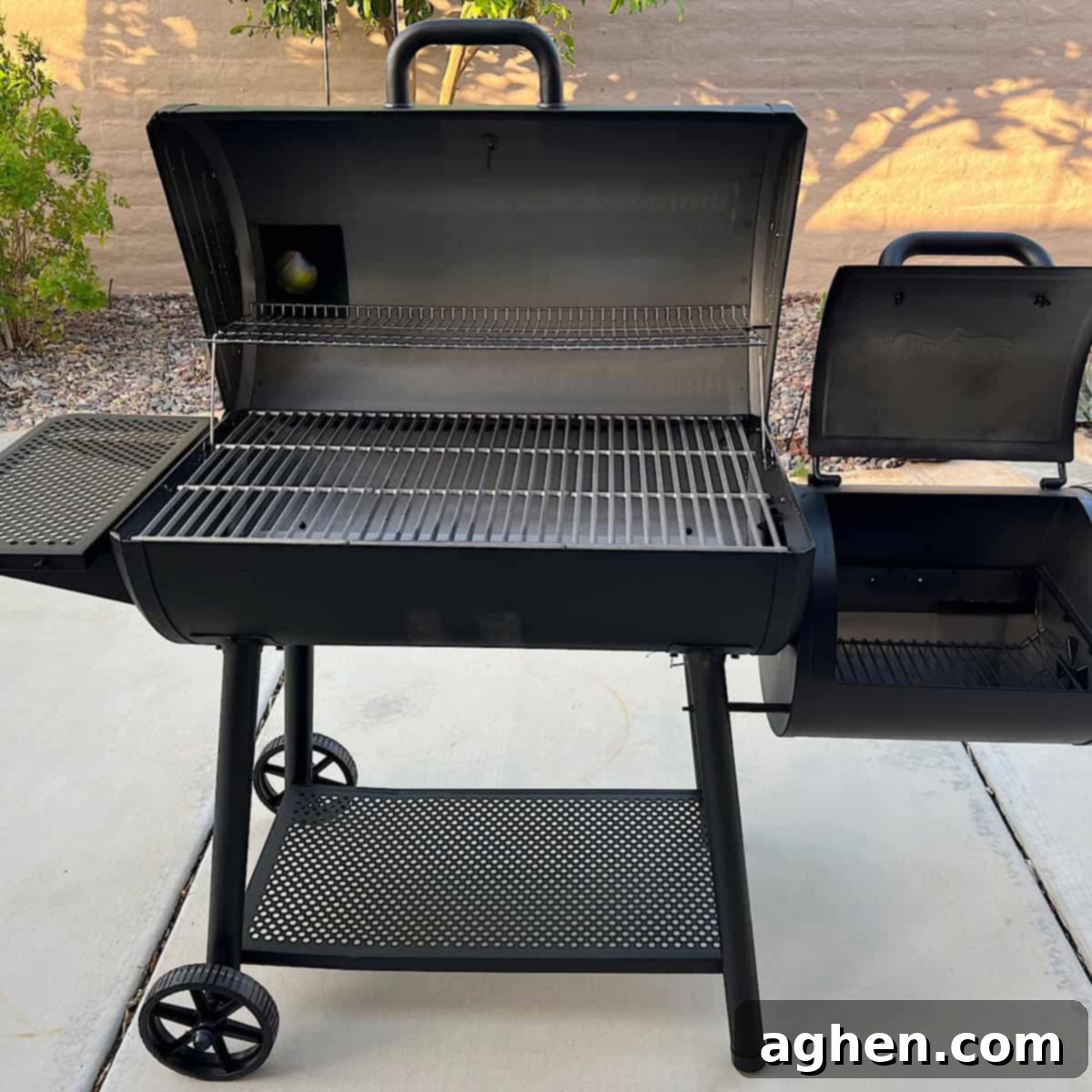
In the world of outdoor cooking, there’s a timeless truth: “Where there’s fire, there’s smoke!” Unlike simply igniting flames for warmth, we barbecue enthusiasts intentionally burn charcoal and wood to create the very essence of flavor – smoke. This ancient practice, elevated to an art form, transforms humble cuts of meat into culinary masterpieces through a delicate dance of heat and aromatic smoke. Embarking on the journey of meat smoking is an incredibly rewarding experience, offering both a challenge and immense satisfaction.
As you delve into this exciting world and get your new offset smoker set up, be sure to explore my perfectly smoked baby back ribs recipe! It’s a fantastic way to put your new skills to the test and taste the incredible results.
1. How is Smoking Meat Different from Grilling?
While both grilling and smoking involve cooking with fire, their methodologies and results are vastly different. Grilling typically involves cooking meat directly or indirectly over high heat, aiming for quick cooks, char, and seared flavors. It’s often about convenience and a crispy exterior.
Smoking, on the other hand, is a slow and deliberate culinary process. It involves cooking meat inside a closed chamber where the temperature is carefully controlled, usually between 225°F and 275°F (107°C and 135°C). The magic happens as natural smoke, produced by burning wood and charcoal, gently flows over the meat for extended periods, often many hours. This low-and-slow approach allows tough cuts to tenderize beautifully as fats render and collagens break down, infusing the meat with complex, savory, and often sweet or tangy smoke flavors that simply cannot be replicated by grilling. The constant exposure to aromatic smoke gradually penetrates the meat, creating a distinct “smoke ring” and an irresistible bark. This primordial method of wood, fire, smoke, and meat delivers an unparalleled depth of flavor that is truly addictive, both for the cook and the diner. This is why “barbecue” in most parts of the country refers specifically to smoked meats, and any reputable BBQ joint prides itself on its smoking technique.
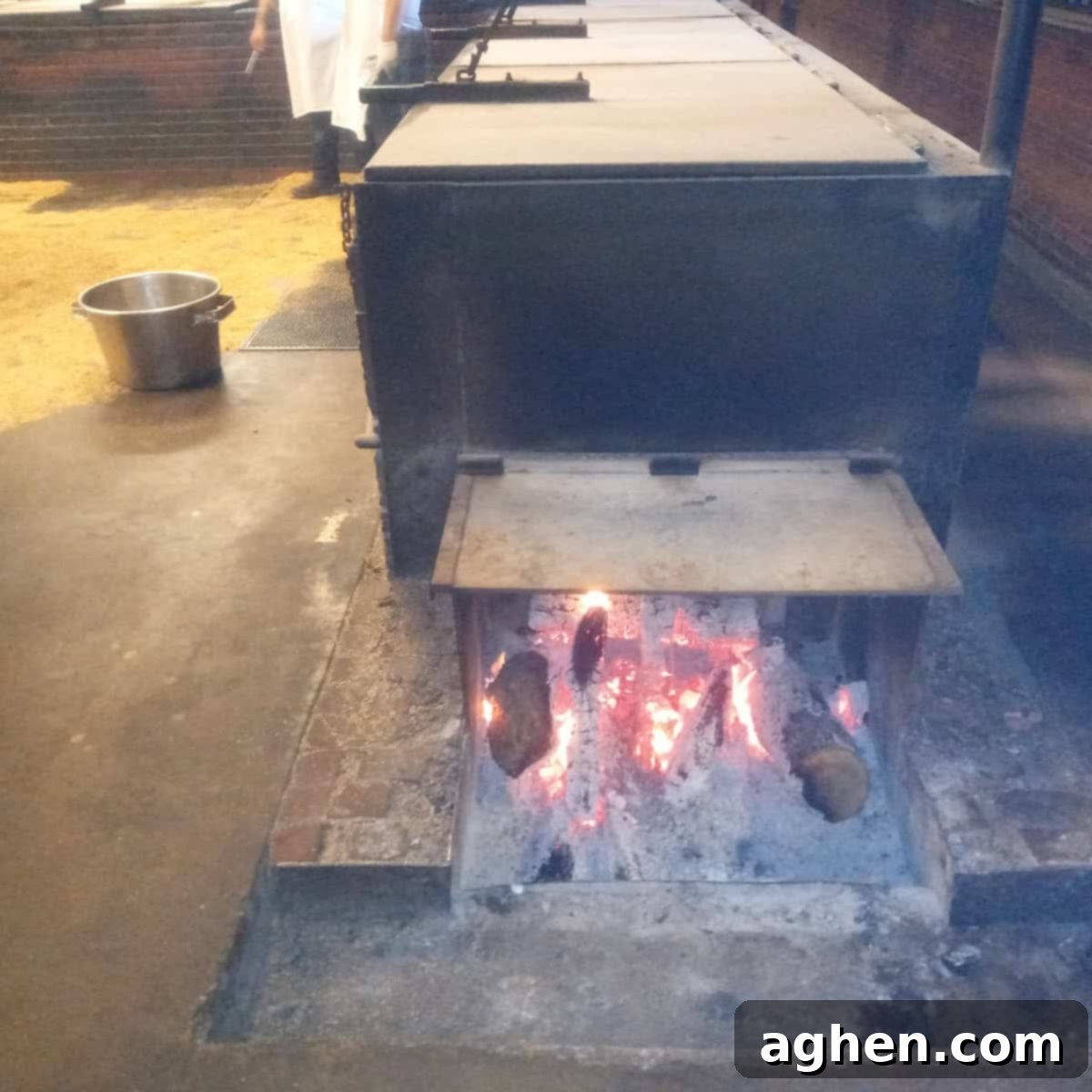
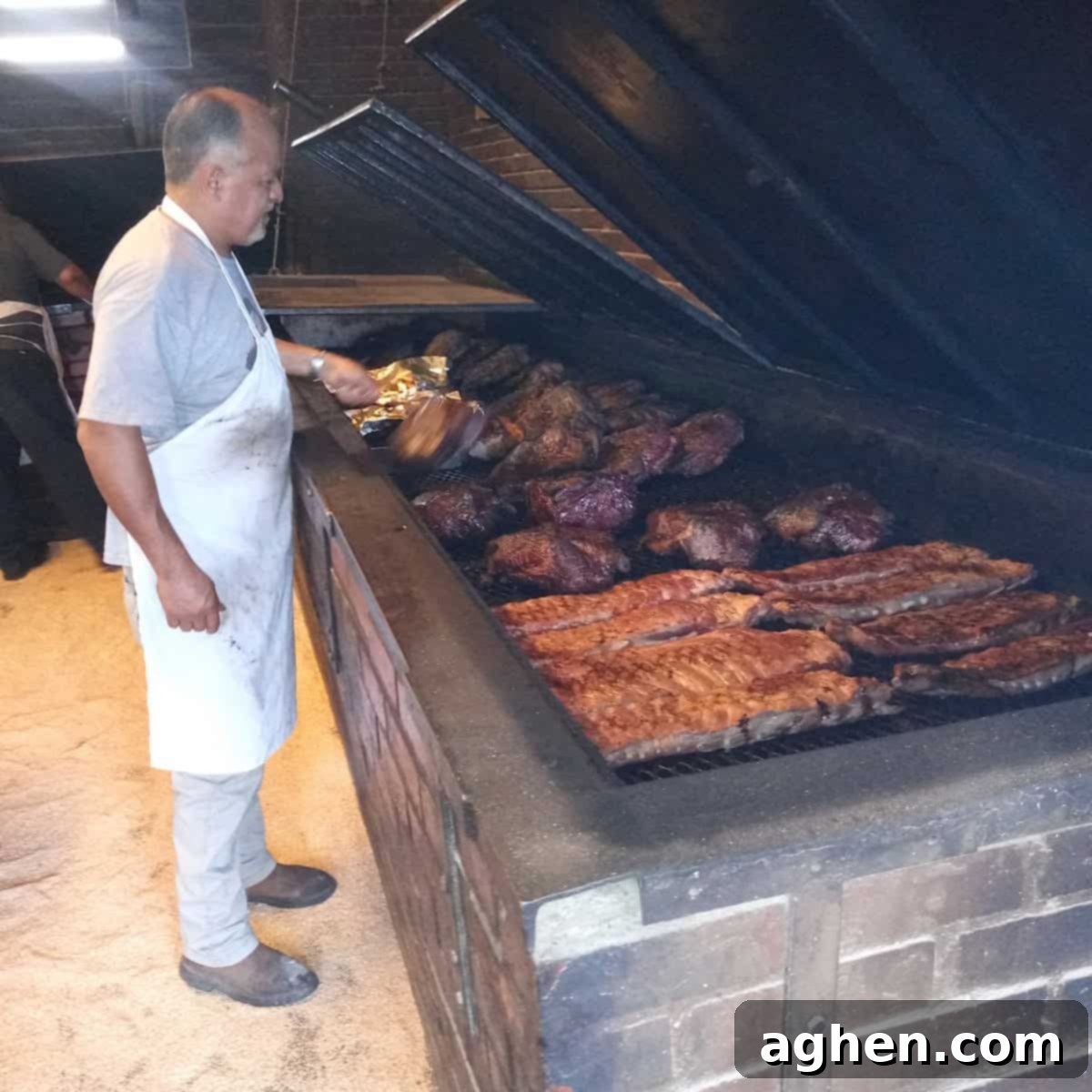
Utilizing an offset smoker is arguably one of the most traditional, hands-on, and rewarding ways to achieve authentic, slow-smoked barbecue. The unique design of an offset smoker ensures that smoke gently envelops the meat, layering on incredible flavors and creating a truly memorable culinary experience.
2. What is an Offset Smoker and How Does It Work?
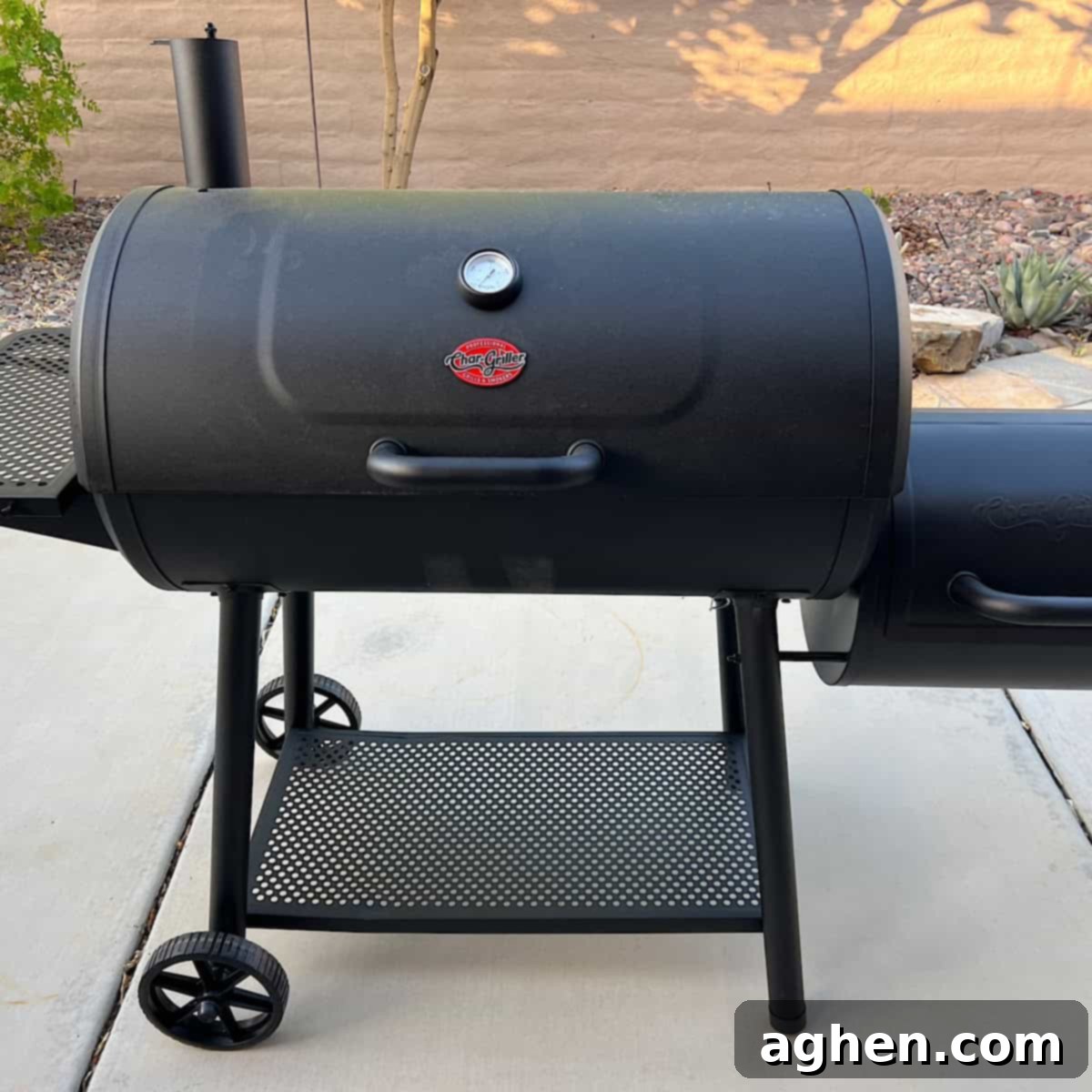
An offset smoker is characterized by its horizontal cooking chamber and a smaller, separate firebox “offset” to the side. This design allows for indirect heat cooking, where the heat and smoke from the firebox travel through the main cooking chamber and then exit via a chimney. Understanding the interplay of its three main components is key to mastering temperature and smoke control: more air generally means more heat, while less air translates to lower temperatures.
- The Firebox – This crucial component is located on the side of the main cooking chamber. It’s where you build and maintain your fire using charcoal and wood. The firebox is equipped with adjustable dampers (vents) that you manually open or close to control the amount of oxygen feeding the fire. This directly impacts the combustion rate, thereby regulating the temperature inside the entire smoker and the volume of smoke produced. Learning to manage these dampers is fundamental to successful smoking.
- The Cooking Chamber (or Grill) – This is the primary compartment where your meat rests on grates, patiently absorbing heat and smoke. Often referred to as “real estate” in the smoking community, the size of this chamber determines how much food you can smoke at once. Heat and smoke from the firebox enter this chamber, circulate around your food, and then exit through the chimney. The indirect nature of the heat here ensures slow, even cooking without scorching.
- The Chimney – Positioned at the opposite end of the firebox, the chimney serves as the exhaust for smoke and heat. It also plays a vital role in creating the draft that pulls air through the firebox and across the cooking chamber. Like the firebox dampers, the chimney often has a damper (sometimes called a stack cap or flue) that allows you to further fine-tune airflow and heat retention. Opening it more increases draw and heat, while closing it down helps hold in heat and smoke. Proper management of both firebox and chimney dampers is critical for maintaining stable temperatures and producing clean, flavorful smoke.
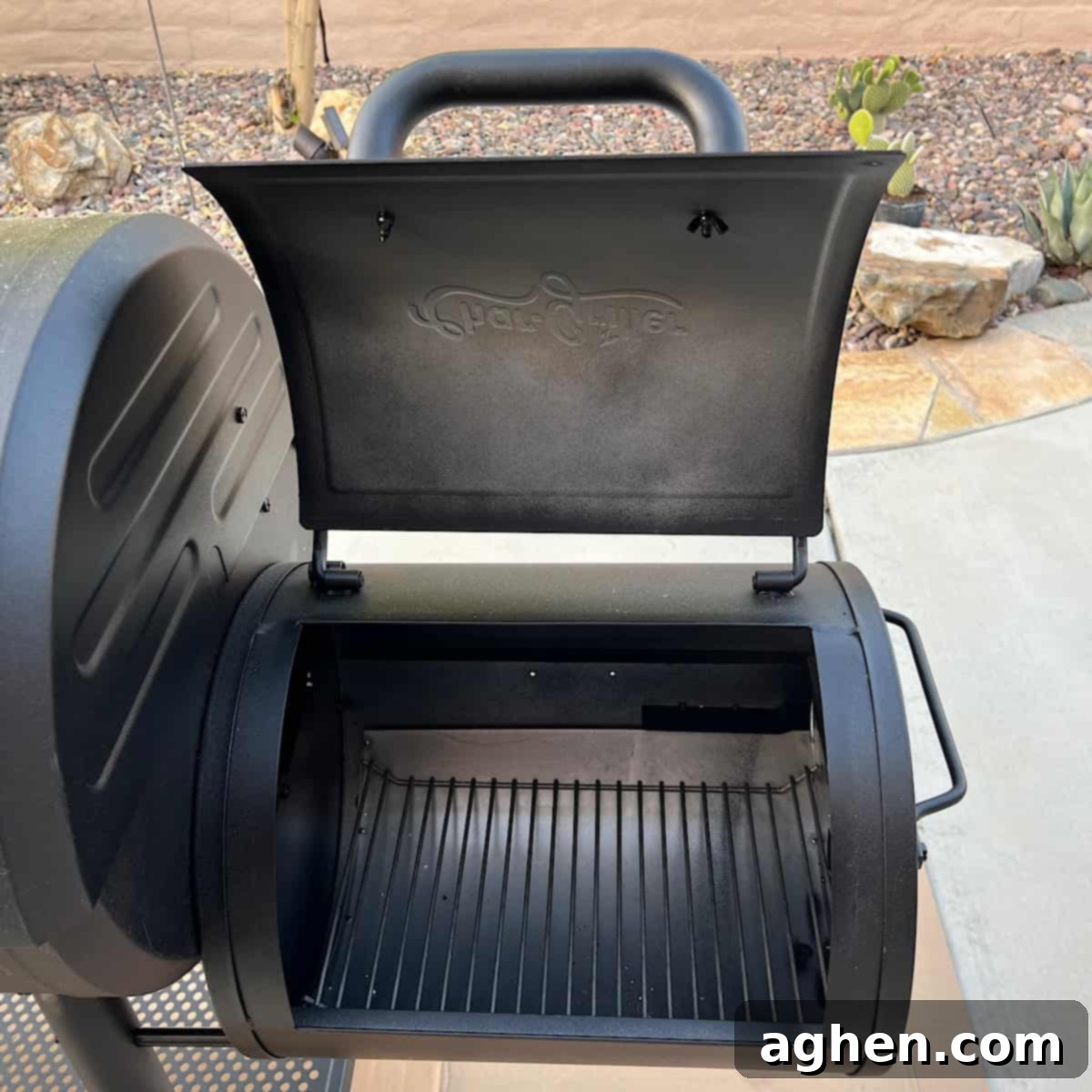
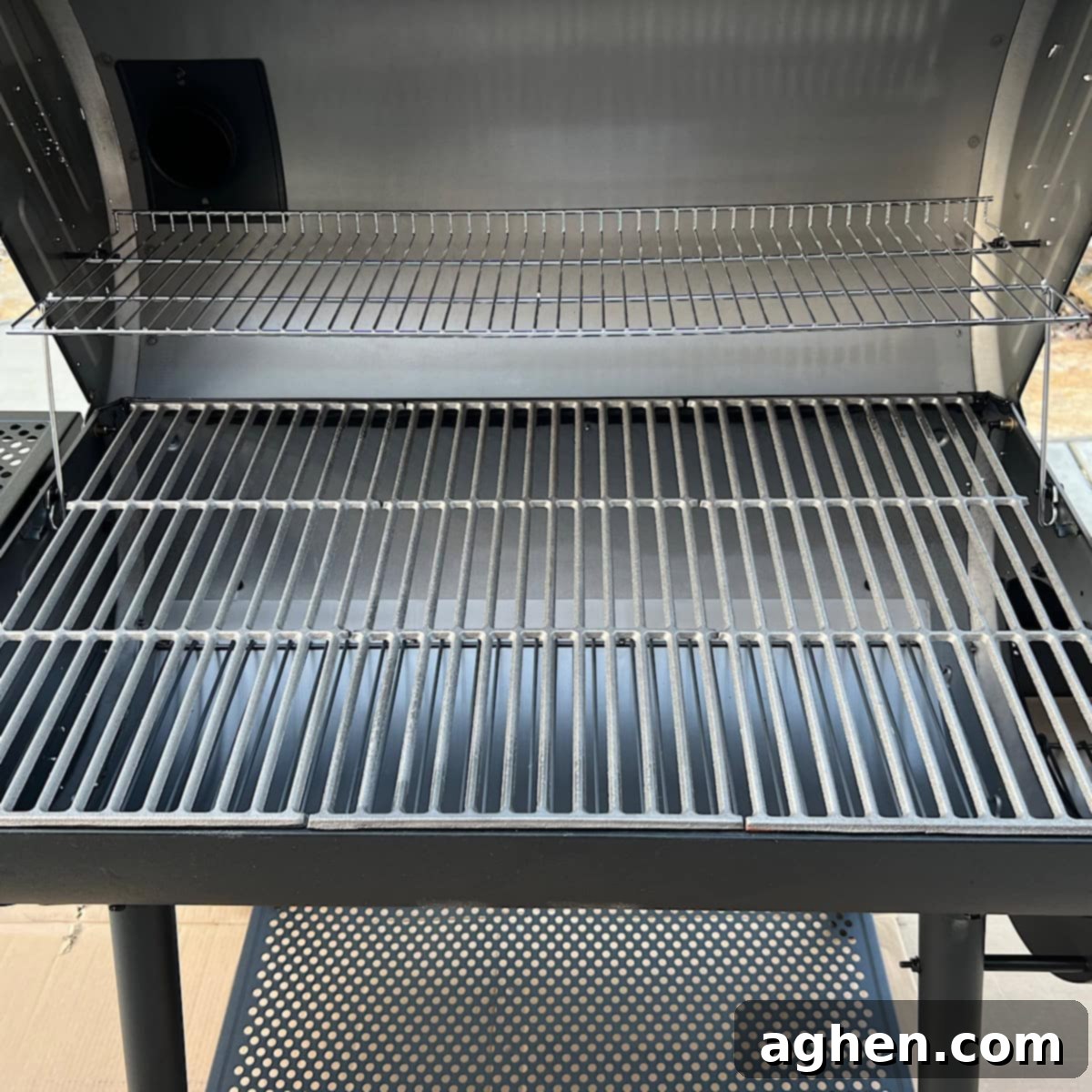
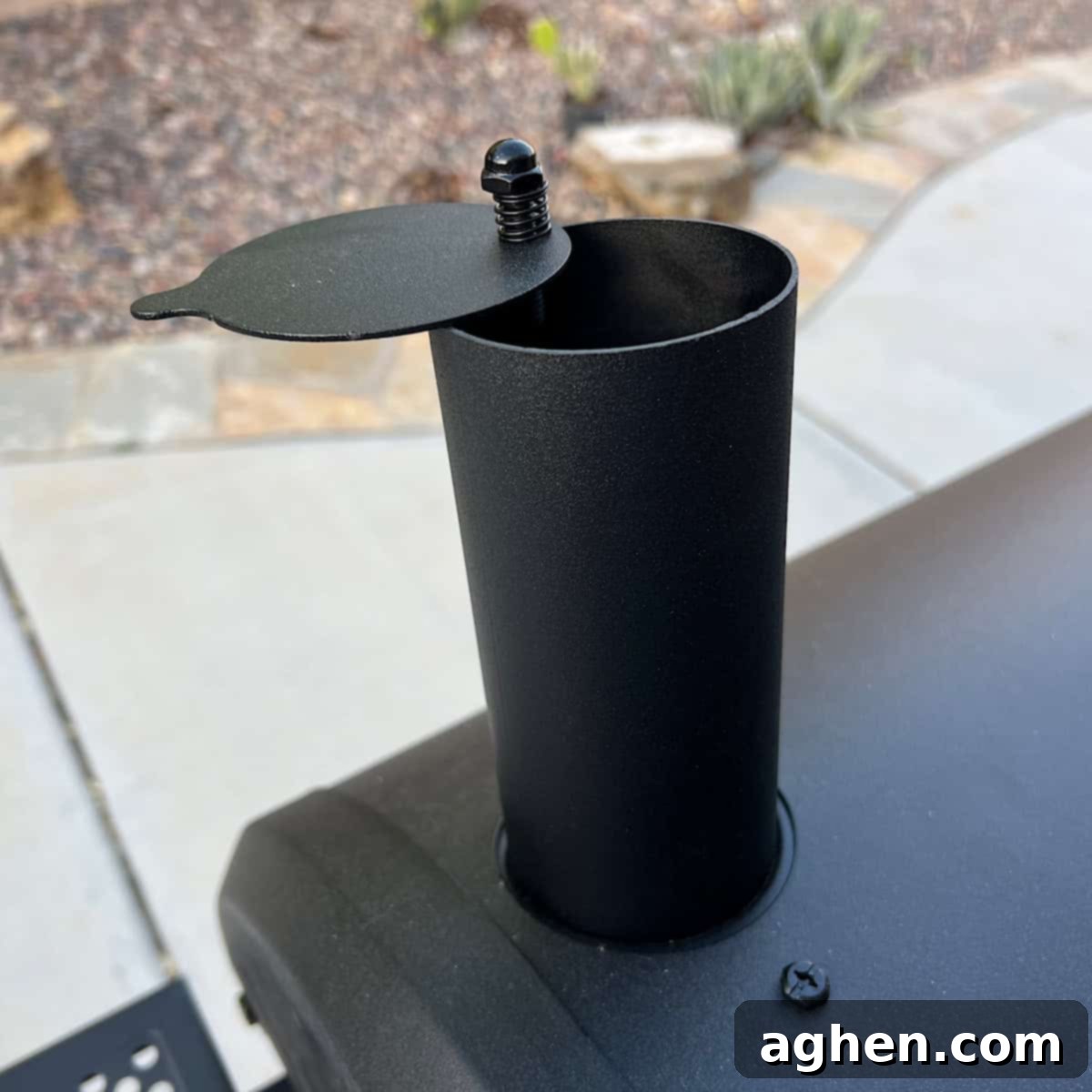
3. Where Can I Buy My Offset Smoker?
The good news is that acquiring an offset smoker is quite straightforward, with various retail options available to suit your preferences and budget. You can find a wide selection at most large hardware and home improvement stores, often referred to as “Big Box stores” (like Lowe’s, Walmart, or Home Depot), as well as dedicated BBQ specialty shops, and numerous online retailers.
Based on personal experience, Home Depot often offers an extensive selection, both in-store and through their online platform. One significant advantage of purchasing in-store is the option to pick up an assembled unit, which saves considerable time and effort. If you opt for online ordering, the smoker will typically be delivered in its box, requiring self-assembly. I’ve consistently found Home Depot’s customer service to be excellent, with staff often knowledgeable enough to discuss the nuances of different offset smoker models and help you make an informed decision. Exploring their range is a great starting point for any aspiring pitmaster.
You can browse the list of offset smokers available at Home Depot here: Smokers – Grills – The Home Depot
4. What Size Offset Smoker Should I Buy and How Much Will It Cost?
When selecting an offset smoker, size and construction quality are paramount. Most manufacturers cater to a range of users, from casual beginners to seasoned professionals. For your first offset smoker, I strongly advise against buying the smallest “beginner” models. These are often made with thinner gauge steel, which struggles to retain consistent heat, leading to temperature fluctuations and premature wear and tear. They typically feel flimsy and may not last more than a few seasons. Conversely, professional-grade offset smokers are incredibly robust, offer vast cooking surfaces, and superior heat retention, but they come with a significantly higher price tag and can be cumbersome to manage for a novice.
This leaves the mid-range size offset smoker as the ideal choice for most new enthusiasts. These models strike a perfect balance: they are generally well-constructed with sufficiently thick steel to maintain stable temperatures, are manageable in size, and provide an ample grill surface. A mid-range smoker can comfortably accommodate various combinations of meats, from a couple of briskets to several racks of ribs or a combination of chicken and pork shoulders, making them versatile for family meals and small gatherings. Expect to invest anywhere from $300 to $500 for a quality mid-range offset smoker. This price point usually guarantees better materials, a more stable cooking environment, and a smoker that will serve you well for many years of delicious barbecue.
5. Should I Assemble My New Offset Smoker Myself or Buy It Already Put Together?
Regardless of where you purchase your offset smoker, you’ll likely face the choice of buying it in a box for self-assembly or picking up a preassembled unit. If you opt for a preassembled smoker, be prepared: these units are often very large and heavy. You will almost certainly need a pickup truck or a large trailer for transport, as it simply will not fit into a standard car (trust me, I’ve learned this the hard way!).
For your first offset smoker, I highly recommend buying it in the box (or having it delivered unassembled) and taking the time to assemble it yourself. I’ve personally done this with every offset smoker I’ve owned, and there are significant benefits to this approach. Assembling your smoker provides an invaluable understanding of its components and how they fit together. You’ll gain intimate knowledge of its structure, learning what each piece is designed to do and how the airflow system operates. This understanding can be incredibly helpful later when it comes to temperature management, troubleshooting, or even making minor modifications. Beyond the practical knowledge, there’s a profound sense of satisfaction and camaraderie that develops with your smoker once you’ve built it with your own hands. Take your time, follow the step-by-step directions carefully, and truly enjoy the process – it’s the first step in your journey to becoming a confident pitmaster.
6. What Other Smoking Equipment Will I Need?
Beyond the smoker itself, a few essential tools will make your smoking experience smoother, more enjoyable, and ultimately more successful:
- Combustibles – These are the heart of your smoke flavor. You’ll need a combination of charcoal briquettes, lump charcoal, and wood chunks. I prefer a blend of all three to achieve consistent heat and layered smoky flavors.
- Charcoal Chimney Starter – This device is a game-changer! After years of struggling with lighter fluid or slow-starting fires, the charcoal chimney revolutionized my BBQ routine. It eliminates the need for chemical fire starters, gets your charcoal red-hot in just 10 to 15 minutes, and ensures a clean, even burn from the start. Simply fill it with charcoal, place a piece of newspaper underneath, light it, and let physics do the rest.
- Long-Handled Tongs – An indispensable utensil. You’ll use tongs not only to move meat around the hot grill grates but also for safely adding more wood to your firebox, adjusting hot coals for even heat distribution, and generally managing your fire without burning yourself. Look for sturdy, long tongs for maximum reach and control.
- Spray Bottles (Two) – These are vital for both fire management and meat hydration. Keep one filled with water to quickly douse any unwanted flare-ups in the firebox, which can cause dirty smoke and acrid flavors. The second bottle should be filled with a liquid like apple juice, apple cider vinegar, or even beer. You’ll use this to “spritz” your meat throughout the smoking process, keeping it moist, aiding in bark formation, and adding a subtle layer of flavor.
- Grill Brush/Scraper – Essential for maintaining cleanliness and longevity of your smoker. A good grill brush or scraper will help you remove cooked-on residue from the grates after each use, preventing sticking and ensuring a clean cooking surface for your next smoke.
- Meat Thermometers (Internal and Ambient) – While your new offset smoker likely has a built-in thermometer, these are often inaccurate or only measure the temperature at a specific spot. You will need at least two reliable thermometers:
- Ambient/Pit Thermometer: A separate digital probe thermometer with a clip to monitor the actual temperature directly at your cooking grate level within the main chamber. This is crucial for maintaining your target smoking temperature.
- Instant-Read Meat Thermometer: Absolutely essential for checking the internal doneness of your meats. Smoking involves reaching specific internal temperatures for safety and tenderness, and an accurate, fast-reading thermometer is your best friend here.
- Heat-Resistant Gloves – Protect your hands when handling hot grates, moving hot coals, or even wrapping large cuts of meat.
- Butcher Paper or Aluminum Foil – For wrapping meat during the “stall” phase, which helps to power through the cook and keep the meat moist.
- Sharp Knife and Cutting Board – For trimming meat before smoking and slicing after resting.
7. What Are the Varieties of Combustibles to Use?
The type of fuel you use significantly impacts the heat profile and, most importantly, the flavor of your smoked meats. A good pitmaster understands the characteristics of each and often uses a combination.
- Charcoal Briquettes – These are the familiar pillow-shaped charcoal lumps, typically made from compressed sawdust and binders. Briquettes provide a consistent and long-lasting heat source, making them an excellent base for starting your fire in the firebox. They burn predictably, which helps in maintaining stable temperatures over long smoking sessions.
- Lump Charcoal – Considered “true” charcoal, lump charcoal is made by slowly burning whole pieces of wood in an oxygen-deprived environment at high temperatures. It contains no additives or fillers, resulting in a cleaner burn and a more natural wood flavor. Lump charcoal burns hotter and often faster than briquettes but can be less uniform in size, making temperature management a bit more dynamic. Many pitmasters use it for its purer smoke flavor and higher heat output.
- Wood Chunks (or Splits) – This is where the magic of smoke flavor truly comes from! Once you have a base of glowing charcoal, you add wood chunks (or larger wood splits for bigger smokers) on top of the embers. The smoldering wood produces the aromatic smoke that penetrates and flavors your meat. Different wood types impart distinct flavor profiles:
- Hickory: Strong, classic barbecue flavor, great for pork butts and ribs.
- Oak: Medium, versatile flavor, excellent with beef brisket.
- Apple/Cherry: Mild, fruity, and slightly sweet, perfect for poultry and pork.
- Mesquite: Intense, earthy, and bold, often used sparingly with beef or wild game.
Experimenting with various wood types is a key part of discovering your signature smoke flavor.
For example, here’s where you can find charcoal and wood options at Home Depot: Lump Charcoal/Wood – The Home Depot
8. What Size Wood Will I Need, and Where Can I Buy My Wood?
For offset smokers, the ideal size of wood is generally referred to as a “chunk.” To visualize this, imagine your cell phone; a wood chunk for smoking is typically about half the size of your phone, or roughly the size of the palm of your hand. This size is perfect because it smolders slowly, producing a consistent stream of clean, flavorful smoke for an extended period without burning too quickly or generating excessive heat. Avoid wood chips, which burn too fast and can produce acrid smoke, and full logs unless your firebox is specifically designed for them.
If you are fortunate enough to live in an area where firewood is readily available year-round, you’re in luck! Many local firewood purveyors or even arborists often have smaller chunks of leftover wood from processing larger logs that they are happy to give away or sell for a nominal fee. Don’t hesitate to ask if they can cut wood to your desired “chunk” specifications. This can be a very cost-effective way to source quality smoking wood.
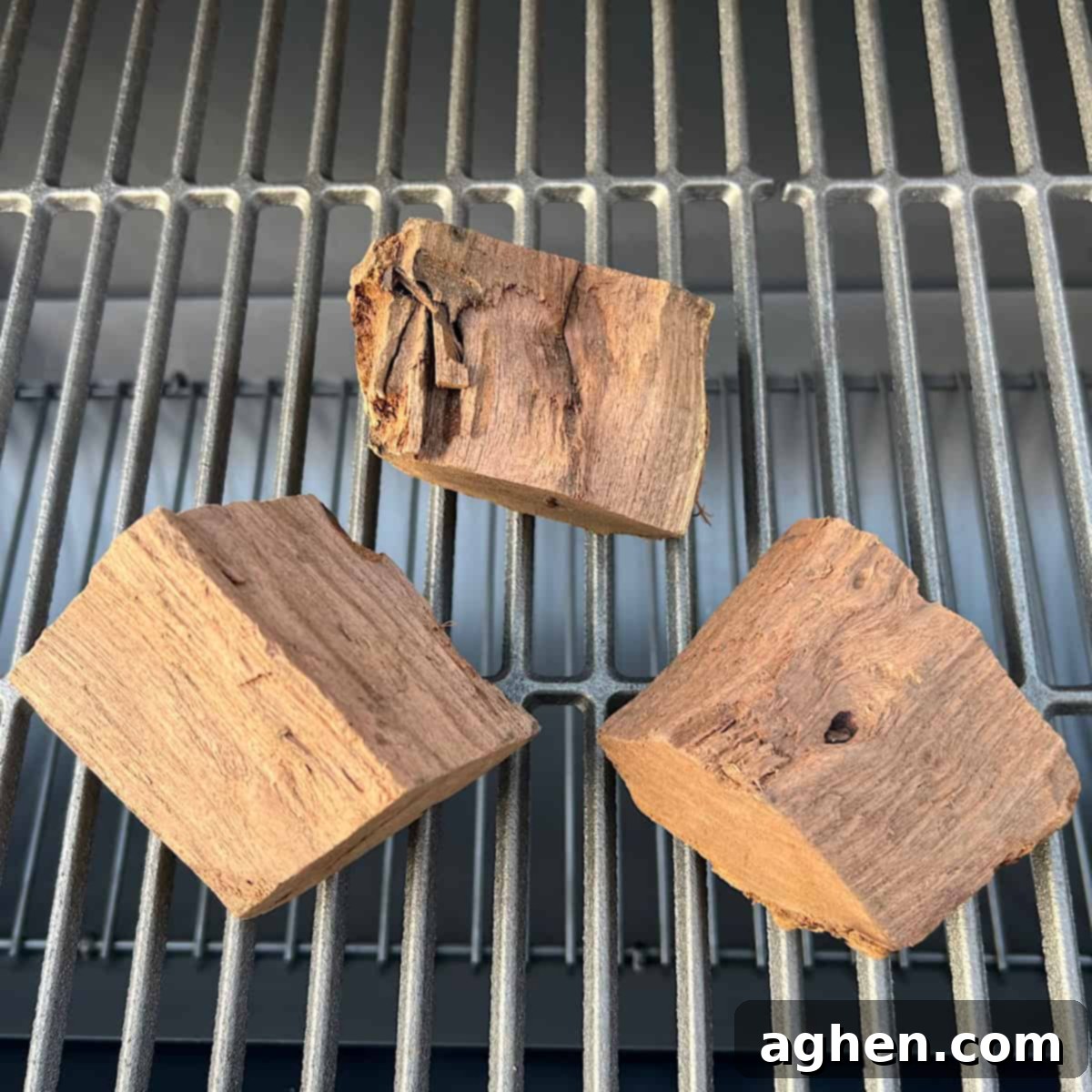
If local firewood sources are scarce, don’t despair. Most hardware stores, garden centers, and even many grocery stores carry bagged chunks of wood specifically for smoking in their BBQ sections. These are usually packaged by wood type (hickory, apple, cherry, oak, etc.), allowing you to experiment with different flavor profiles. Always ensure that any wood you use for smoking is untreated, chemical-free, and specifically intended for cooking to avoid introducing harmful substances or undesirable flavors to your food.
9. Should I “Season” My Smoker?
Yes, absolutely! Seasoning your new offset smoker is a crucial first step that should never be skipped. Think of it like seasoning a cast-iron pan; it serves multiple vital purposes:
- Removes Manufacturing Residues: New smokers, especially those fresh from the factory, often have leftover manufacturing oils, paints, dust, or other chemical residues on their surfaces. Burning these off before cooking ensures they won’t transfer unwanted flavors or potentially harmful substances to your food during your first smoke.
- Cures Paint/Protective Coatings: Many smokers come with a heat-resistant paint on the exterior. Seasoning helps cure this paint, making it more durable and preventing it from flaking or emitting odors during future cooks.
- Creates a Non-Stick Surface and Protective Layer: During seasoning, a thin layer of cooking oil is applied and baked onto the internal surfaces. This creates a slightly non-stick surface, making cleaning easier in the long run, and helps to establish a protective barrier against rust, especially important for steel components.
- Builds a Flavorful “Patina”: Over time, the smoke and rendered fats will build up a dark, flavorful layer (a “patina”) inside your smoker. The initial seasoning process kickstarts this development, which contributes to the overall character and flavor of your barbecue.
How to Season Your Offset Smoker:
- Clean Thoroughly: Before you even light a fire, wipe down all interior surfaces with warm, soapy water to remove any loose dust or debris. Rinse and dry completely.
- Apply Oil: Lightly coat all interior surfaces – including the grates, inside the cooking chamber, and the firebox – with a high smoke-point cooking oil like vegetable oil, canola oil, or lard. Use a paper towel to apply a thin, even layer. Avoid excessive oil, as it can cause flare-ups.
- Build a Fire: Start a modest fire in your firebox using charcoal and a few small pieces of wood.
- Heat and Hold: Open all air flow dampers (firebox intake and chimney exhaust) to allow for good airflow. Let the internal temperature of your smoker gradually climb to approximately 350-450 degrees Fahrenheit (175-230 degrees Celsius).
- Burn Off: Maintain this temperature for about 2-3 hours. This allows the oils to bake onto the metal and burn off any residual manufacturing compounds. During this process, you will likely see smoke, which is normal.
- Cool Down: After the designated time, close the dampers and allow the smoker to cool down naturally.
- Catch Drips: It’s a good idea to place a large piece of cardboard or newspaper under your offset smoker during this process, especially under the firebox and main chamber, to catch any initial drippings or paint residue that might occur.
Most offset smoker manufacturers will also provide specific seasoning instructions in the Owner’s Manual, which you should always consult for model-specific recommendations.
10. Is There Anything Else I Need to Know Before I Fire Up My Offset Smoker for the First Time?
Venturing into the world of smoking meats with an offset smoker is a journey that beautifully blends art and science. It’s a craft that demands planning, meticulous execution, and, perhaps most importantly, patience. These three components are your unwavering allies, ensuring your smoking process is not only enjoyable but culminates in consistently delicious results.
Understand that smoking meat is a slow endeavor. Depending on the cut and size, cooking times can range anywhere from 4 to 12 hours, or even longer for large briskets. This extended duration means you’re investing significant time, not just in the cooking, but also in learning and growing as a proficient offset smoker. Each cook is an opportunity to fine-tune your fire management, understand the nuances of smoke, and read the meat’s progression.
Here are a few final tips for your initial forays:
- Practice Temperature Control: Your first few cooks should focus on maintaining a consistent temperature. Don’t worry about cooking a prize-winning brisket; instead, practice managing your firebox dampers and chimney to keep the smoker within your target range (e.g., 225-275°F).
- Read the Smoke: Aim for “thin blue smoke,” which is nearly invisible and has a slightly sweet aroma. Thick, white, acrid smoke indicates an incomplete burn and will impart a bitter flavor to your food. Adjust airflow to get clean combustion.
- Trust Your Thermometer: Always cook to internal temperature, not just time. This is the single most important factor for food safety and optimal tenderness.
- Embrace the “Stall”: Don’t be alarmed if your meat’s internal temperature plateaus for hours. This is a common phenomenon called the “stall” as moisture evaporates from the surface, cooling the meat. Be patient and ride it out, or consider wrapping your meat in butcher paper or foil to power through it.
- Rest Your Meat: After smoking, always allow your meat to rest, loosely tented with foil, for at least 30 minutes, or even longer for large cuts. This allows the juices to redistribute, resulting in a more tender and flavorful product.
Smoking meats with an offset smoker often evolves from a hobby into a genuine passion, almost an addiction for many. The sense of accomplishment that comes from nurturing a fire, coaxing incredible flavors from raw ingredients, and finally presenting a perfectly smoked piece of meat is incredibly satisfying. The ultimate reward, however, is the pure joy of eating your finished smoked meat—barbecue sauce smeared across your face and hands, a contented smile, and a warm glow in your heart from a job exceptionally well executed. This deeply gratifying experience makes every moment invested in learning and mastering the offset smoker truly worthwhile.
